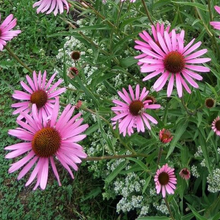Echinacea tennesseensis 'Rocky Top' is a compact rare coneflower species with narrow upward facing pink petals and a coppery cone. Thrives in full sun and lean soils offering drought tolerance and high wildlife value. Its upright form and long blooming nature make it a standout in native and pollinator plantings.
Height & Spread: 18 - 24 in x 12 - 18 in
Bloom Time: Early summer to late summer
Light Requirements: Full sun
Soil Preference: Dry to medium, well drained soils; tolerant of shallow rocky soils
Watering Needs: Low once established
Deer Resistance: Generally avoided by deer
Native Status
This species is native to a small region of central Tennessee and is federally listed as threatened. Cultivated selection that maintains the species’ distinctive upward facing flowers.
WILDLIFE & INSECTS
Butterflies
- Attracts Monarchs, Painted Ladies, and Great Spangled Fritillaries for nectar throughout the summer.
Bees
- Provides pollen and nectar to long tongued bees including bumblebees and leafcutter bees.
Birds
- Seed heads are a valuable food source for goldfinches and other songbirds in late summer and fall.
Spacing & Landscape Use
Spacing Recommendations
- Space 12 - 18 in apart to allow upright clumps to form without crowding.
Landscape Placement
- Ideal for prairie restorations, pollinator gardens, and dry borders. Pairs well with grasses and other drought tolerant natives in mass or matrix plantings.
Companion Plants
- Schizachyrium scoparium (Little Bluestem) - Adds texture and warm toned fall foliage that enhances Echinacea’s late season display.
- Rudbeckia fulgida (Black Eyed Susan) - Blooms in unison and shares similar habitat preferences, creating a bright summer palette.
- Monarda fistulosa (Wild Bergamot) - Offers lavender flowers that attract pollinators and harmonize with pink coneflower blooms.
- Asclepias tuberosa (Butterfly Weed) - Brings orange contrast and supports Monarchs in dry, sunny beds.
- Liatris spicata (Blazing Star) - Provides vertical purple spikes that flower in succession for continued pollinator attraction.



